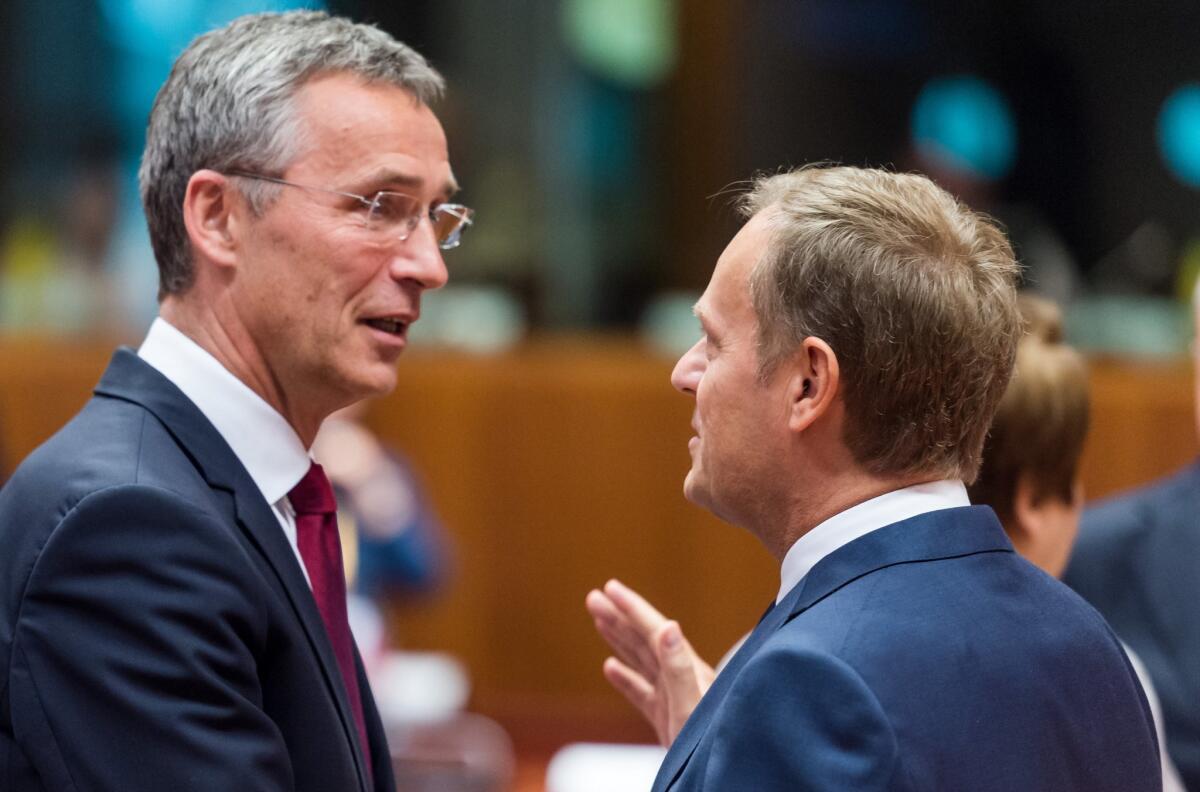Russia and NATO raising stakes with military buildups and rhetoric

European Council President Donald Tusk, right, speaks with NATO Secretary-General Jens Stoltenberg during a meeting between the Western military alliance and officials of the European Union, which is also enduring strained relations with Russia.
Russia and NATO have embarked on rival arms buildups and toughened their posture and rhetoric against each other, raising the security stakes between the two former Cold War adversaries while claiming to be reacting defensively to the other’s threats.
Defense ministers of the U.S.-led North Atlantic Treaty Organization wrapped up a two-day gathering in Brussels on Friday that followed announcements that the Pentagon would deploy hundreds of tanks, armored vehicles, artillery and transports to six Eastern European countries that were once part of or allied with the Soviet Union.
As the Western alliance officials firmed up plans for their new rapid-reaction force to respond to dangers they see emanating from Russia and the Middle East, a senior Russian security official cast the moves as evidence that Washington and its “flaccid” European allies are aiming to dominate Russia.
“They would like very much to see Russia cease to exist as a country,” Russian Security Council chief Nikolai Patrushev told the newspaper Kommersant in an interview widely distributed by other state-run media.
Patrushev, who was director of the KGB-successor Federal Security Service for the decade before he was tapped to head the security council in 2008, portrayed the war in Ukraine as a U.S.-instigated disturbance to blame on Russia and undermine the regional balance of power between the Cold War-era rivals.
Russian President Vladimir Putin and other Kremlin officials have issued stern warnings of “consequences” should NATO deploy troops and armaments to Eastern Europe.
U.S. Defense Secretary Ashton Carter announced during his tour this week of NATO’s eastern flank that the alliance would be positioning equipment and arms for a bolstering of defenses against any Russian aggression. The military buildup is destined for Estonia, Latvia, Lithuania, Poland, Romania and Bulgaria -- all former Soviet republics or satellites that Moscow still considers part of its “sphere of influence.”
Russia and the United States are embarked on massive military modernization programs that will commit hundreds of billions of dollars to upgrading defenses and armaments.
The Kremlin launched its $500-billion, decade-long defense upgrade in 2010, and Putin has said the program will be spared cutbacks even though the Russian economy is in recession and most other government spending is being pared sharply.
At an arms fair near Moscow this month, Putin announced that at least 40 new nuclear-capable intercontinental ballistic missiles would be deployed by the end of the year to confront what the Kremlin said in its newly revised defense doctrine is the greatest threat to Russian national security: NATO.
Carter responded to Putin’s latest reminder to the West of his country’s vast nuclear arsenal by telling reporters accompanying him on his European tour that “nuclear weapons are not something that should be the subject of loose rhetoric by world leadership.”
On Thursday, Deputy Defense Secretary Robert Work told the House Armed Services Committee that Putin and other Russian leaders were “playing with fire” in raising the specter of nuclear warfare.
The United States, which provides the bulk of NATO’s weapons and funding, is also planning a major upgrade of its nuclear armaments that will cost a minimum of $355 billion over the next decade, the congressional representatives were told.
Work appealed to the U.S. lawmakers for more funding for the Pentagon to avoid having to cut into other important defense needs.
“Without additional funding dedicated to strategic forces modernization, sustaining this level of spending will require very, very hard choices and will impact the other parts of the defense portfolio,” Work said.
Follow @cjwilliamslat for the latest international news 24/7
More to Read
Start your day right
Sign up for Essential California for news, features and recommendations from the L.A. Times and beyond in your inbox six days a week.
You may occasionally receive promotional content from the Los Angeles Times.






